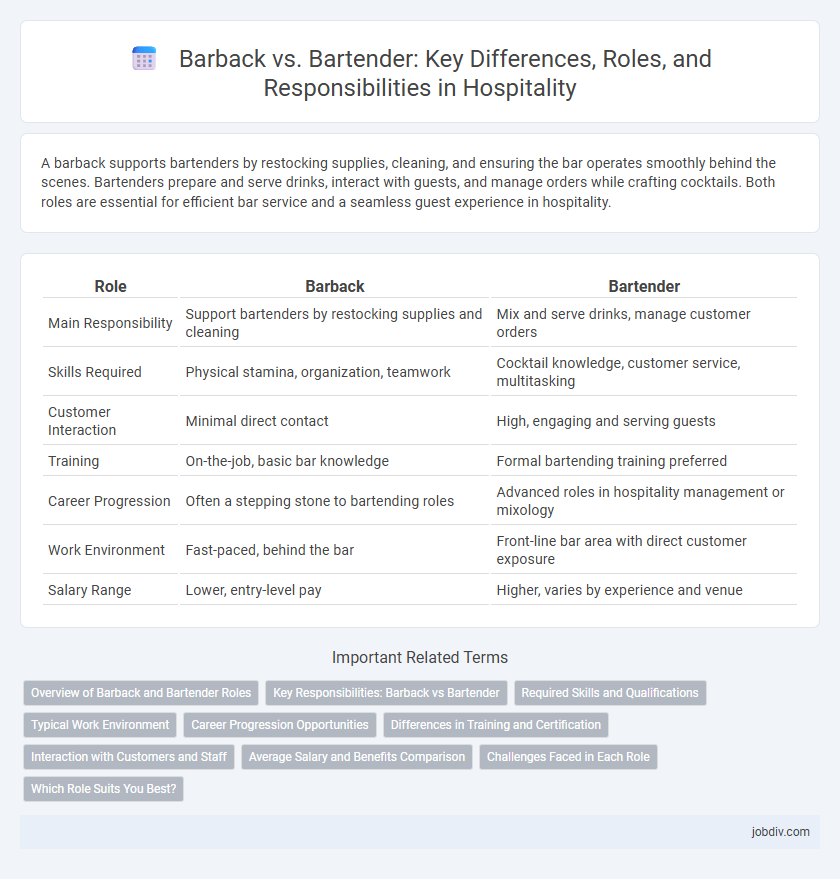A barback supports bartenders by restocking supplies, cleaning, and ensuring the bar operates smoothly behind the scenes. Bartenders prepare and serve drinks, interact with guests, and manage orders while crafting cocktails. Both roles are essential for efficient bar service and a seamless guest experience in hospitality.
Table of Comparison
| Role | Barback | Bartender |
|---|---|---|
| Main Responsibility | Support bartenders by restocking supplies and cleaning | Mix and serve drinks, manage customer orders |
| Skills Required | Physical stamina, organization, teamwork | Cocktail knowledge, customer service, multitasking |
| Customer Interaction | Minimal direct contact | High, engaging and serving guests |
| Training | On-the-job, basic bar knowledge | Formal bartending training preferred |
| Career Progression | Often a stepping stone to bartending roles | Advanced roles in hospitality management or mixology |
| Work Environment | Fast-paced, behind the bar | Front-line bar area with direct customer exposure |
| Salary Range | Lower, entry-level pay | Higher, varies by experience and venue |
Overview of Barback and Bartender Roles
Barbacks support bartenders by maintaining stock, cleaning glassware, and ensuring the bar operates smoothly during busy hours, allowing bartenders to focus on mixing drinks and engaging with customers. Bartenders manage drink preparation, cocktail creation, and customer service, taking orders and providing a personalized experience. Both roles are essential for efficient bar operations, with barbacks handling logistical tasks and bartenders delivering skilled beverage service.
Key Responsibilities: Barback vs Bartender
Barbacks primarily focus on maintaining the bar's organization by restocking supplies, cleaning glassware, and supporting bartenders during busy shifts to ensure efficient service. Bartenders are responsible for crafting cocktails, engaging with customers, managing cash transactions, and creating a welcoming atmosphere. Both roles are essential to the bar's operation, with bartenders leading customer interactions and barbacks providing critical behind-the-scenes support.
Required Skills and Qualifications
Barbacks require strong physical stamina, excellent organizational skills, and the ability to multitask efficiently to support bartenders by restocking supplies and maintaining cleanliness. Bartenders must possess advanced mixology knowledge, excellent customer service skills, and the ability to manage high-pressure environments while crafting cocktails and engaging with guests. Both roles demand a good understanding of beverage inventory, strong communication skills, and adherence to safety and hygiene standards.
Typical Work Environment
Barbacks typically work in fast-paced, high-energy bar settings where they support bartenders by restocking supplies, cleaning glassware, and maintaining the bar area, often during peak hours to ensure smooth service. Bartenders operate directly behind the bar, mixing drinks, interacting with customers, and managing cash transactions in environments ranging from casual pubs to upscale lounges. Both roles require standing for long shifts, often in loud, crowded spaces that demand strong multitasking and physical stamina.
Career Progression Opportunities
Barbacks serve as essential support staff, gaining hands-on experience with inventory management and customer service, which lays a strong foundation for advancing to bartending roles. Bartenders hold more responsibility, mixing drinks, managing bar operations, and building customer relationships, offering greater opportunities for career growth into supervisory or managerial positions in the hospitality industry. Progressing from barback to bartender often leads to higher earnings, skill development, and potential paths into bar management or event coordination.
Differences in Training and Certification
Barbacks typically undergo on-the-job training focused on stocking supplies, glassware, and assisting bartenders, with minimal formal certification required. Bartenders usually complete specialized training programs covering mixology, customer service, and alcohol safety, often earning certifications such as TIPS or ServSafe Alcohol. The distinct educational pathways reflect their differing responsibilities: bartenders are skilled in drink preparation and regulatory compliance, while barbacks support operational efficiency.
Interaction with Customers and Staff
Bartenders engage directly with customers, taking orders, offering drink recommendations, and creating a personalized experience that enhances customer satisfaction. Barbacks support bartenders by maintaining stock levels, cleaning glassware, and ensuring that the bar operates smoothly, facilitating efficient service. Interaction with staff for bartenders includes coordinating with barbacks and servers to manage workflow, while barbacks primarily communicate with bartenders to replenish supplies promptly.
Average Salary and Benefits Comparison
Barbacks typically earn an average salary ranging from $25,000 to $35,000 annually, while bartenders command a higher average salary between $30,000 and $50,000, reflecting their greater skill requirements and customer interaction. Benefits for bartenders frequently include tips, health insurance, and flexible schedules, whereas barbacks often receive fewer perks and rely mainly on hourly wages. Employers may offer bartenders opportunities for advancement and bonuses, enhancing total compensation beyond base salary.
Challenges Faced in Each Role
Barbacks face challenges such as maintaining constant stock levels, swiftly restocking supplies during peak hours, and managing heavy lifting in a fast-paced environment. Bartenders encounter pressure to multitask expertly, create consistent and high-quality drinks under time constraints, and manage customer interactions while ensuring compliance with safety regulations. Both roles demand physical stamina and the ability to work efficiently in a high-energy, demanding hospitality setting.
Which Role Suits You Best?
Barbacks support bartenders by restocking supplies, cleaning bar areas, and ensuring smooth service during busy hours, making it ideal for those who prefer behind-the-scenes work and physical tasks. Bartenders take center stage by mixing drinks, engaging with customers, and managing orders, suited for individuals with strong communication skills and a flair for creativity. Assessing your strengths in customer interaction versus operational support helps determine whether the barback or bartender role aligns best with your career goals in hospitality.
Barback vs Bartender Infographic

 jobdiv.com
jobdiv.com